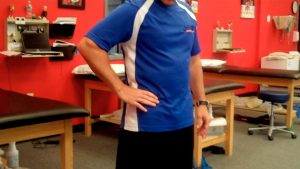Femoroacetabular impingement (FAI) is now a common term in orthopedics. When I first started practicing physical therapy the term did not exist. As a matter of fact, I was told my hip had a bone spur in the early 2000’s, and I am sure it would now be classified as FAI. If you are unfamiliar with it, click here to read a prior post on the basics of it.
Today, as clinicians we face the tough task of helping patients overcome hip pain related to overuse injuries, acute strains, osteoarthritis, myofascial pain, etc. One of the biggest challenges is definitively identifying the etiology of hip pain. Hip pain can be extra-articular (outside the joint) or intra-articular in nature (in the joint). Consider this retrospective study published in AJSM in 2015 by Naal et al. on sonographic presence of groin hernias and adductor tendinopathy with FAI.
Differential diagnoses when ruling in/out FAI include:
- Adductor (groin) strain
- Rectus femoris strain or avulsion
- Iliopsoas tendinitis
- Athletic pubalgia
- Trochanter pain/bursitis
- Femoral neck stress fracture
- Osteitis pubis
- Cancer
- Genitourinary issues
- Low back pain
The list above is certainly not all inclusive. The key to obtaining a more accurate diagnosis involves taking a thorough history, performing a comprehensive exam, and getting appropriate imaging. Click here to learn about a paper on the diagnostic validity of tests to predict intra-articular hip pathology. Soft tissue pain related to muscle strains should improve with rest and treatment, whereas joint pain related to FAI is usually consistently painful or worse with increased repetitive activities such as running, dancing, twisting, jumping, cutting, etc.
Patients with FAI will often cup their hip and make what is referred to as the “C sign” when describing where they feel the pain.

In addition, squatting, lunging, prolonged sitting, abduction and external rotation movements often provoke the pain. The prevailing thought is that bony morphology (how the hip’s acetabulum and/or femur) are shaped directly contribute to injury risk and FAI. Hip dysplasia is an additional mitigating factor.
Below are a few studies available with respect to soccer and hockey players as it relates to FAI given they are often impacted and limited by this condition:
JOSPT article from Mosler et al. looking at ROM in asymptomatic male soccer players
AJSM article from Lerebours et al. on prevalence of cam-type morphology in elite ice hockey players
Some professional organizations are having players with radiographic evidence of FAI undergo surgery to restore joint mechanics even if they are asymptomatic. There is much to learn with respect to the nature of this condition, its treatment and the short and long term impact of hip arthroscopy as it relates to patient outcomes.
Practitioners in Europe, Canada and the UK are putting together a randomized control trial to determine the efficacy hip arthroscopy versus sham procedures for treatment of FAI, in addition to evaluating prognostic factors for long term outcomes after surgical intervention for FAI. Click here to read more about this.
As a clinician who lectures on this topic and rehabs these patients on a regular basis, I can tell you we still have much to learn in order to better guide our patients dealing with FAI. Several factors including age, activity level, extent of bony morphology, strength, mobility, pain level, stability and prior failed conservative care are things we must consider in this population. Rehab should always be the line of first defense in my opinion.
Some patients who are willing to modify activity level and undergo a comprehensive rehab plan are able to successfully manage the condition without surgery. Middle age adults should discuss the level of cartilage damage with their MD to determine if an arthroscopic procedure has merit or merely delays an eventual arthroplasty. CT scans provided a much more detailed look at the joint integrity.
There is a role for corticosteroid injections, PRP, NSAIDs, dry needling and blood flow restriction therapy as well. I have seen BFR and dry needling be helpful in patients with gluteus medium/minimus tendinosis or persistent greater trochanteric pain. We must consider these tissues as sources of pain in addition to FAI.
The hip, much like the shoulder, offers great freedom of movement and function, but not without some compromise. Our future research must continue to scrutinize rehab and surgical algorithms as we search for the optimal way to care for adolescent athletes, professional athletes, weekend warriors, middle age workers, dancers, runners and all others afflicted by FAI.

